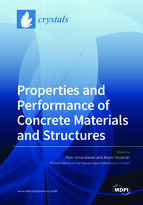Properties and Performance of Concrete Materials and Structures
A special issue of Crystals (ISSN 2073-4352). This special issue belongs to the section "Inorganic Crystalline Materials".
Deadline for manuscript submissions: closed (31 March 2021) | Viewed by 34558
Special Issue Editors
Interests: eco-efficient concrete; high performance fiber reinforced cementitious composites; durability of fiber reinforced concrete; experimental testing and numerical analysis of concrete materials and structures
Special Issues, Collections and Topics in MDPI journals
Interests: engineering of cement based materials; homogeneous substitute material model for reinforced concrete modeling; mechanics of engineering structures; analysis of the explosive impact on building structures; dynamic behavior of reinforced concrete deep beams of very high strength materials; dynamic relaxation method for load capacity analysis of reinforced concrete elements; dynamic response of elastoviscoplastic rectangular ribbed plates; mechanics of material and structural compositions; new system of truss arrangement of steel bars for reinforcement of concrete; non-classical model of dynamic behavior of concrete with dynamic strength criterion; delayed yield effect in dynamic flow of elastic/visco-perfectly plastic material
Special Issue Information
Dear Colleagues,
Concrete is one of the most ancient and widely used construction materials. In recent decades, numerous advances and developments were made in the field of concrete that have been implemented in practical applications. Nowadays, the term ‘modern concrete’ refers to concrete with good workability, high fracture toughness, high mechanical strength, and chemical durability. Structural elements from such materials extend the frontiers of design and enable the implementation of outstanding, durable, ecological, and safe structures of the highest quality.
The aim of this Special Issue is to publish current research on concrete composites based on Portland cement or other blended cements and binders with fiber reinforcement and/or containing inclusions of waste materials or special aggregates, e.g., from recycling. This Special Issue focuses on presenting the results of research on the properties and performance of concrete composites, novel experimental techniques, analytical methods, modeling, design, production, and practical applications of these materials, and studies regarding the behaviour of structural components, in-situ performance, renovation, maintenance, demolition, durability, and sustainability of structures made of these composites.
Dr. Piotr Smarzewski
Prof. Dr. Adam Stolarski
Guest Editors
Manuscript Submission Information
Manuscripts should be submitted online at www.mdpi.com by registering and logging in to this website. Once you are registered, click here to go to the submission form. Manuscripts can be submitted until the deadline. All submissions that pass pre-check are peer-reviewed. Accepted papers will be published continuously in the journal (as soon as accepted) and will be listed together on the special issue website. Research articles, review articles as well as short communications are invited. For planned papers, a title and short abstract (about 100 words) can be sent to the Editorial Office for announcement on this website.
Submitted manuscripts should not have been published previously, nor be under consideration for publication elsewhere (except conference proceedings papers). All manuscripts are thoroughly refereed through a single-blind peer-review process. A guide for authors and other relevant information for submission of manuscripts is available on the Instructions for Authors page. Crystals is an international peer-reviewed open access monthly journal published by MDPI.
Please visit the Instructions for Authors page before submitting a manuscript. The Article Processing Charge (APC) for publication in this open access journal is 2600 CHF (Swiss Francs). Submitted papers should be well formatted and use good English. Authors may use MDPI's English editing service prior to publication or during author revisions.
Keywords
- concrete
- high-performance concrete
- ultra-high-performance concrete
- fiber reinforced concrete
- self-compacting concrete
- eco-efficient concrete
- self-healing concrete
- low-impact binders
- concrete structures
- reinforcement
- experimental techniques
- analytical methods
- multiscale modeling methods
- development of design methods
- joints of structural elements
- static, dynamic, and cyclic loadings
- microstructural characterization
- mechanical strength
- damage and fracture processes
- resistance to fatigue, impact, and explosion
- fire protection
- performance in exploitation of concrete structures
- conservation of concrete structures
- demolition of concrete structures
- durability
- sustainability







